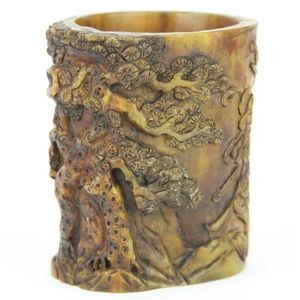Antique Tortoise Shell Etui with Cut Steel Inlay
You must be a subscriber, and be logged in to view price and dealer details.
Subscribe Now to view actual auction price for this item
When you subscribe, you have the option of setting the currency in which to display prices to $Au, $US, $NZ or Stg.
- Tortoiseshell - Tortoiseshell is a translucent material that comes from the horny carapace of a certain types of turtles, including the hawksbill turtle. It is often therefore mounted on a colour underground - often red - or inlaid with gold or silver thread, as seen in Boulle furniture.
The texture and colour nuances of the material are extremely important. Heated tortoiseshell can easily be formed into various shapes. Like other natural materials, tortoiseshell becomes more beautiful with use. In a time before plastic, tortoiseshell was widely used for small objects such as combs and powder compacts.
In 1973, the trade of tortoiseshell worldwide was banned under CITES (The Convention on International Trade in Endangered Species). Prior to importing or exporting items containing tortoiseshell a CITES permit must be obtained. Tortoiseshell items cannot be traded on Ebay.
"Faux tortoiseshell", another case of man initiating nature, is made from old-style plastics such as celluloid and cellulos and is coloured with red, yellow and brown spots to imitate the genuine article. It is commonly used in glasses frames, musical instruments and costume jewellery. - Cut Steel Decoration - Cut steel decoration is a technique used in the production of jewelry and other decorative items that involves cutting steel pieces into small, faceted shapes and then attaching them to a metal base. These small steel pieces, often called "cut steel beads" are then arranged to form intricate designs, and then attached to a metal base to create a piece of jewelry. This technique was popular in the 18th and 19th centuries, particularly during the Georgian and Victorian eras.
The steel pieces were usually cut with a chisel and hammer, the process was time consuming and labor-intensive, and required a high level of skill. The steel was cut and shaped into small beads or other decorative shapes, and then polished to a high shine. These beads were then strung together or attached to a metal base to create a piece of jewelry or other decorative item.
Cut steel decoration was often used to create jewelry, such as necklaces, bracelets, and earrings, as well as other decorative items, such as buttons and buckles. The jewelry was particularly popular during the Georgian and Victorian eras, as it was considered fashionable and was relatively inexpensive to produce.
This item has been included into following indexes:
Visually similar items

Antique black lacquered jewellery box with ornate gilt decoration, 19 cm wide

Good Chinese silver gilt enamelled canister, lobed sides with blue enamelled decoration. Lidded. Marked silver to base. Height 9.5 cm Wt. 188grams

A very finely carved bamboo libation cup in a rhinoceros horn-shape, 19th/20th century, the deep carving follows the contour of the vessel with a continuous berry & leaf pattern, height 18, diameter 18 cm

Horn carved brush pot decorated with cherry blossom trees, chrysanthemum & Chinese caligraphy. Condition good, minor age related wear to the base. Height 10 cm
